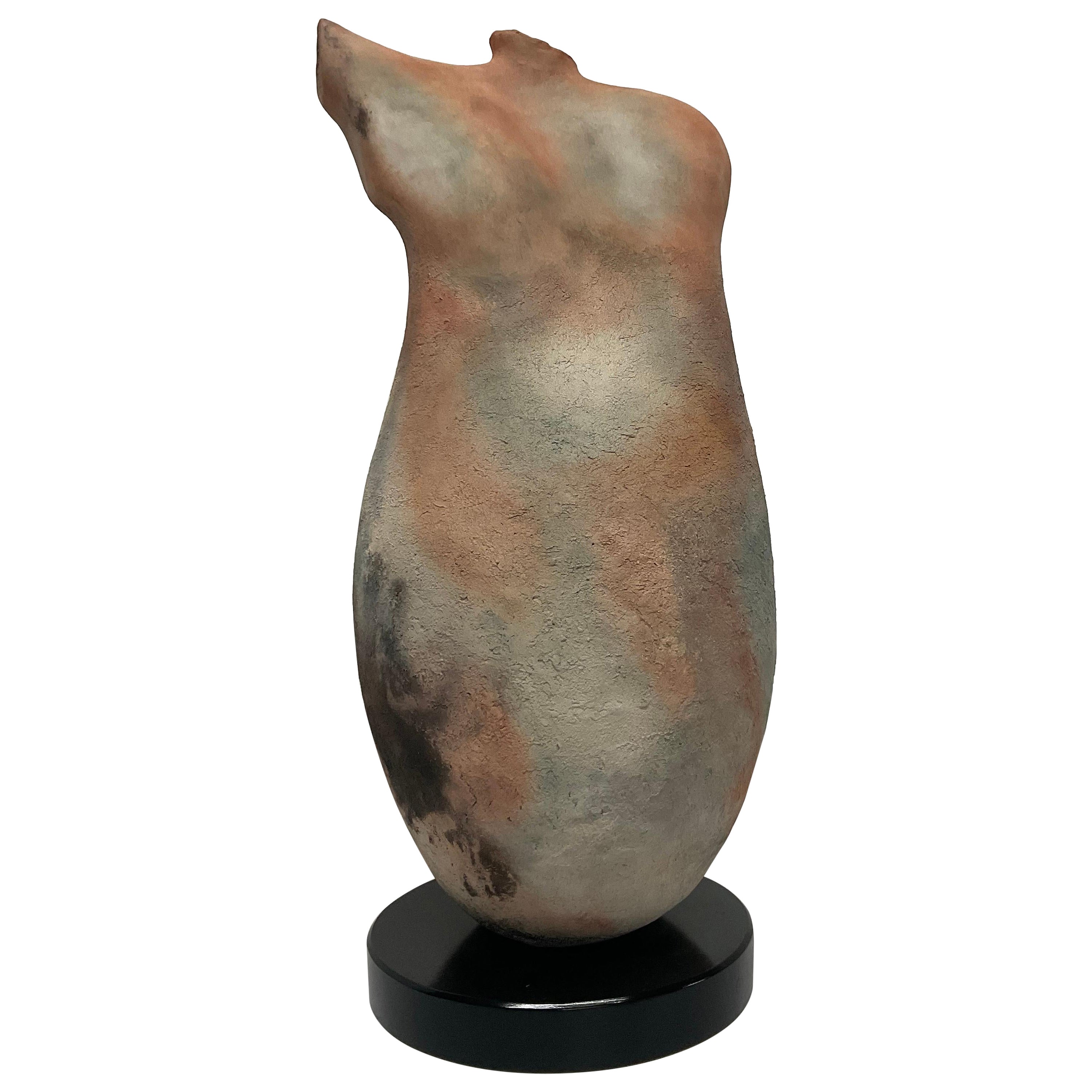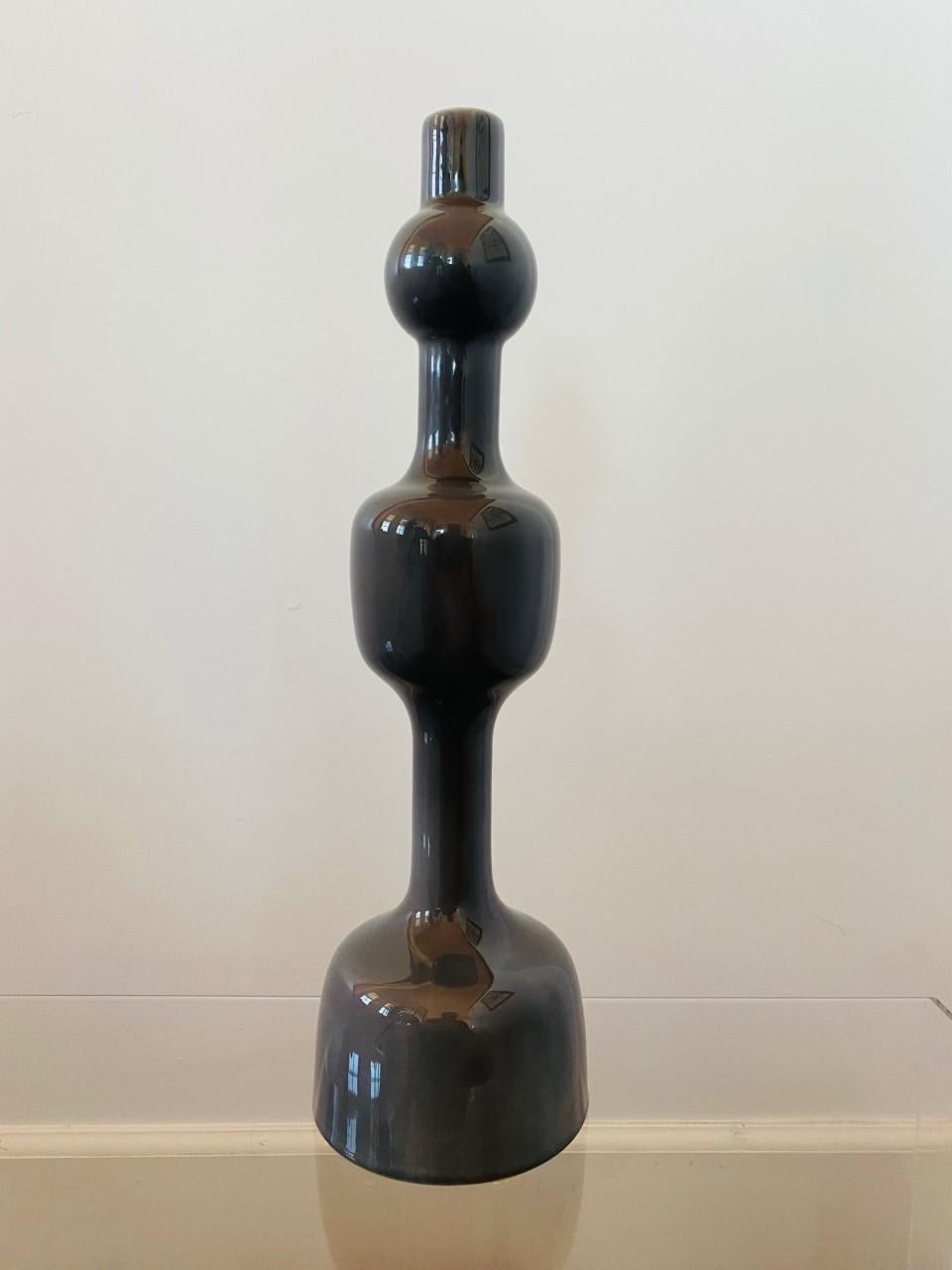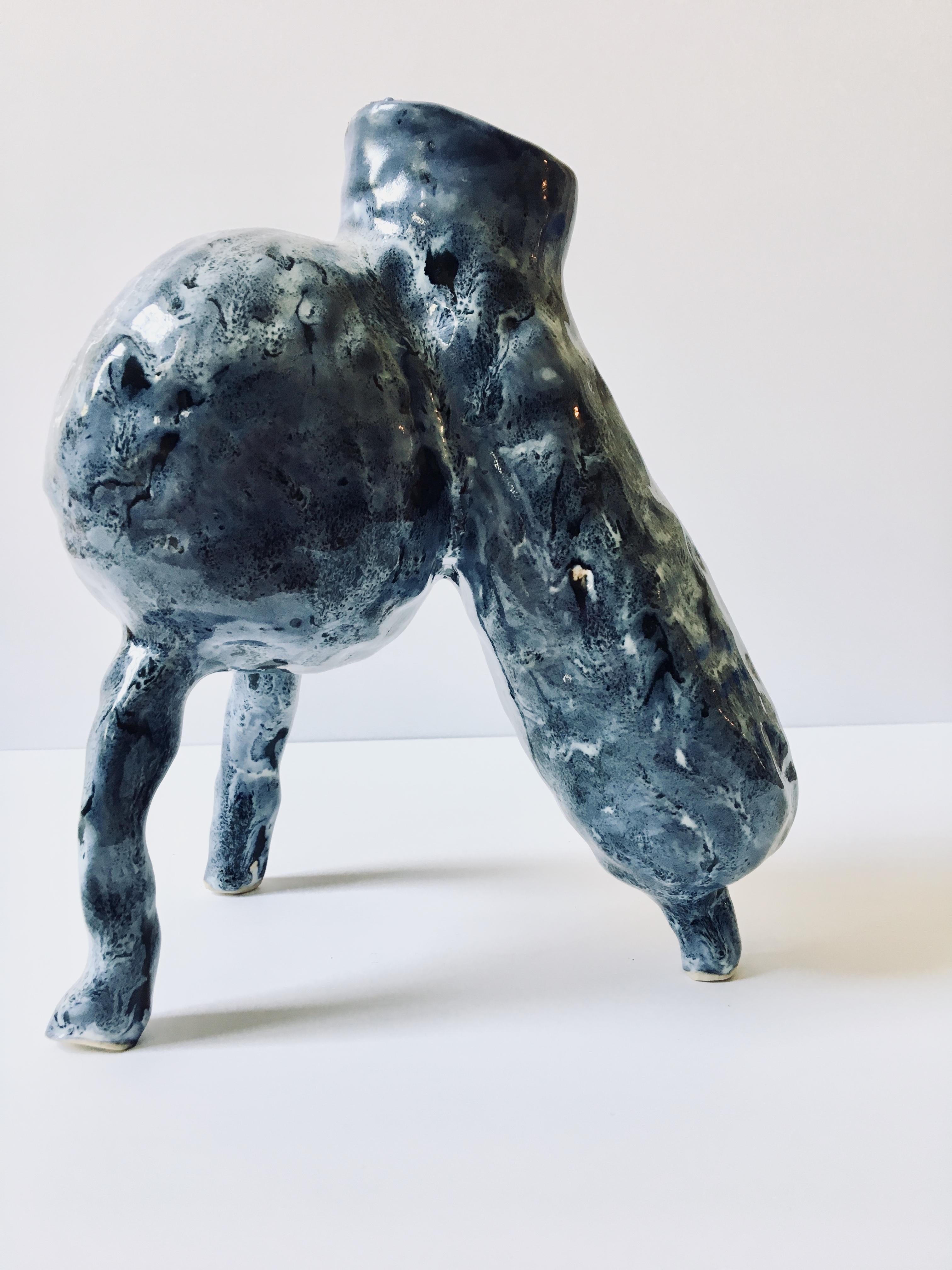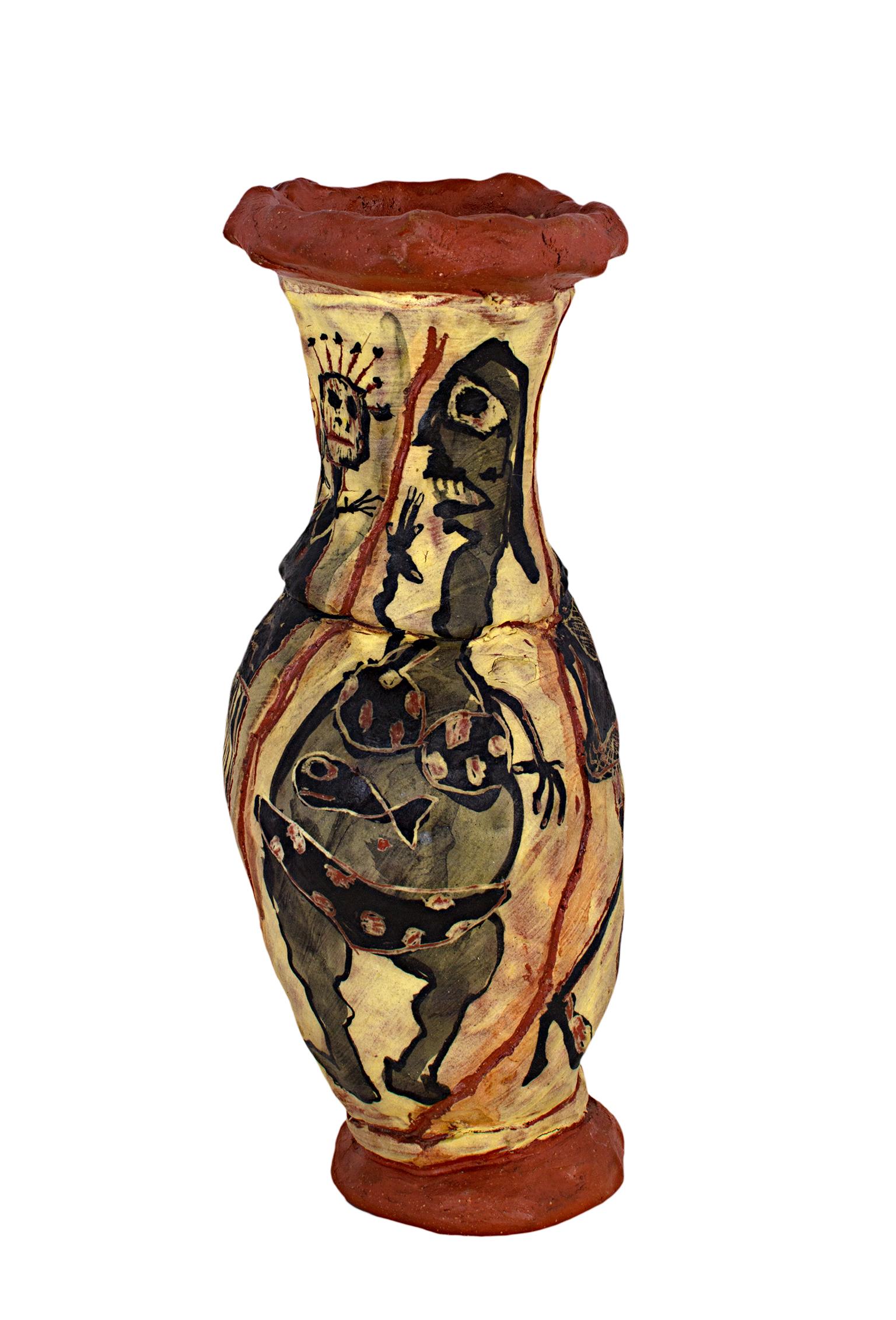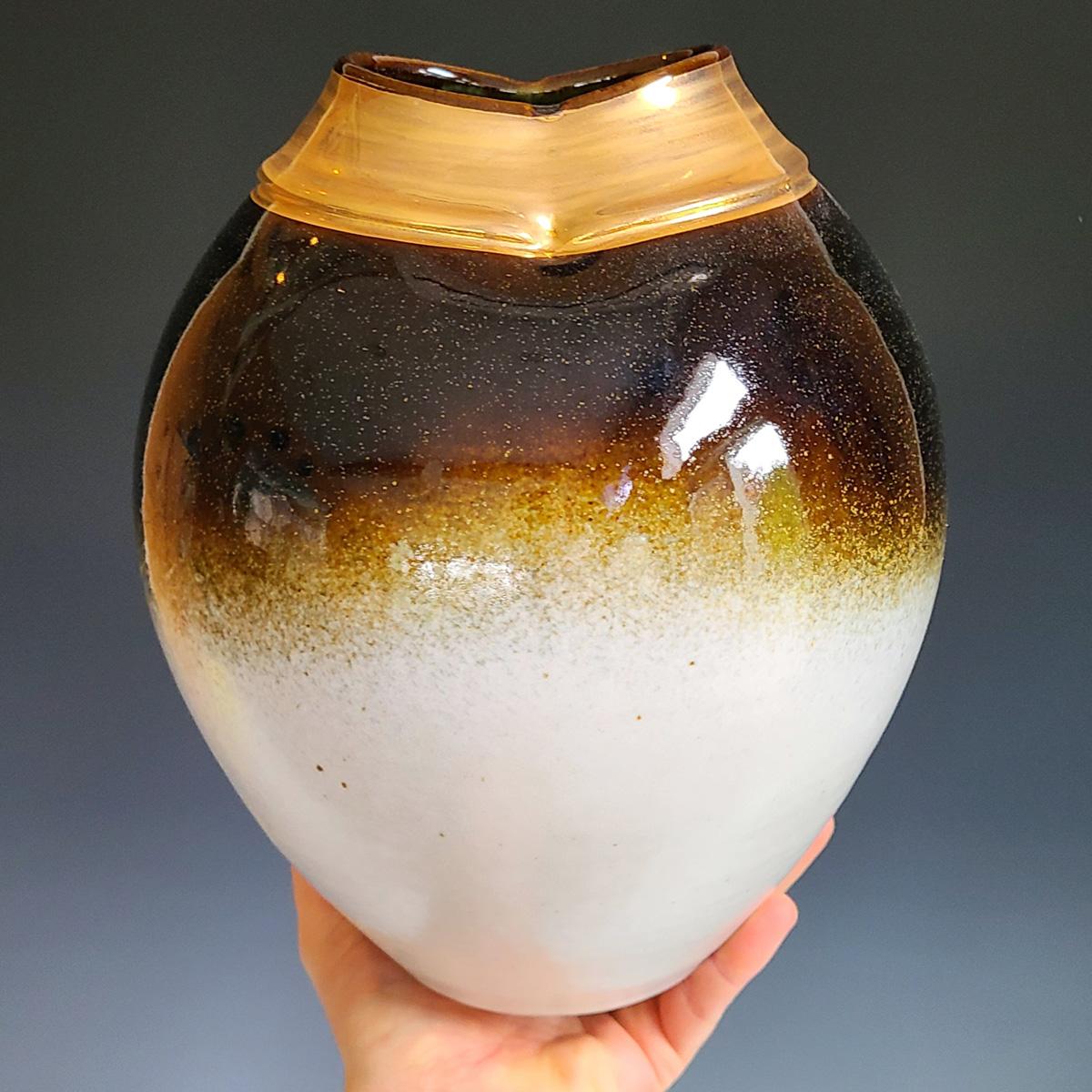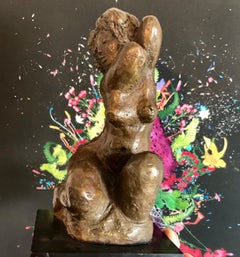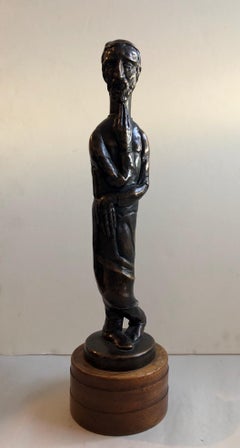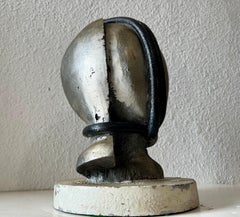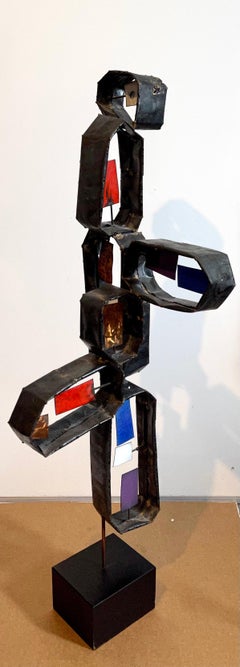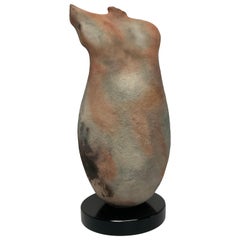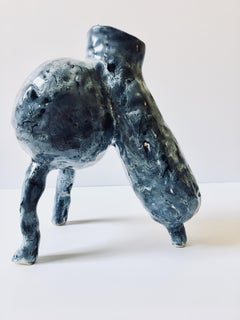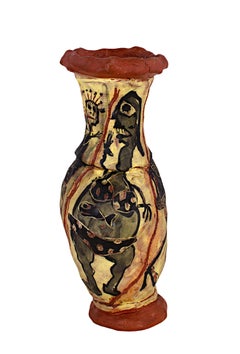Items Similar to Brutalist Ceramic Sculpture Vase Bronze Lustre FInish California Expressionist
Want more images or videos?
Request additional images or videos from the seller
1 of 12
Jenik CookBrutalist Ceramic Sculpture Vase Bronze Lustre FInish California Expressionist
$1,800
£1,357.38
€1,569.87
CA$2,525.39
A$2,807.13
CHF 1,471.44
MX$34,281.83
NOK 18,370.04
SEK 17,282.78
DKK 11,717.08
About the Item
Jenik Cook
Handmade ceramic vase or pot sculpture
Hand signed by the artist.
Fired clay with a luster bronze painted finish
Jenik Esterm Simonian Cook is a painter and ceramicist sculptor in the tradition of such visual theorists as Arshile Gorky, Wassily Kandinsky, and Robert Motherwell. She studied with Chalita Robinson and Alex Vilumsons. She has had a solo show at the Beatrice Wood center. Cook is renowned as an abstract-expressionist with an oeuvre that consists of figurative and abstract nude sculptures, luster pottery and paintings with acrylic, oil and watercolor. Absorbing and processing a vast range of material, from ancient languages to modern painting movements, her works convey a sense of confidence over this broad spectrum of experience. Her biomorphic modernism, shapes and lines, coupled with her bold use of color infuse her painting with richly exotic symbolism in the style of Joan Miro and Fernand Leger. Her ceramic work was influenced by the studio pottery movement and Peter Voulkos. Known for her technical brilliant and startling use of light and color, Jenik Cook incorporates a plethora of references from literature, and mythology, to landscape and personal relationships. She brings her knowledge of painting, sculpture and the arts to every piece. At its core her art is an experiment of movement, light, contemplation and ritual, each perfectly composed in order to touch the viewer on a more profound level. Early on, she took a cue from Edvard Munch whose work inspired her to put her life story in visual form. Now, Jenik's work tells that story abstractly with a vibrancy and expression that move from the container of her picture into the viewer's psyche. Her work is a celebration of generous form and color.
- Creator:Jenik Cook (1940, American)
- Dimensions:Height: 8 in (20.32 cm)Width: 5 in (12.7 cm)Depth: 5 in (12.7 cm)
- Medium:
- Movement & Style:
- Period:
- Condition:Please see photos for details.
- Gallery Location:Surfside, FL
- Reference Number:1stDibs: LU38214258302
About the Seller
4.9
Platinum Seller
Premium sellers with a 4.7+ rating and 24-hour response times
Established in 1995
1stDibs seller since 2014
1,800 sales on 1stDibs
Typical response time: <1 hour
- ShippingRetrieving quote...Shipping from: Surfside, FL
- Return Policy
Authenticity Guarantee
In the unlikely event there’s an issue with an item’s authenticity, contact us within 1 year for a full refund. DetailsMoney-Back Guarantee
If your item is not as described, is damaged in transit, or does not arrive, contact us within 7 days for a full refund. Details24-Hour Cancellation
You have a 24-hour grace period in which to reconsider your purchase, with no questions asked.Vetted Professional Sellers
Our world-class sellers must adhere to strict standards for service and quality, maintaining the integrity of our listings.Price-Match Guarantee
If you find that a seller listed the same item for a lower price elsewhere, we’ll match it.Trusted Global Delivery
Our best-in-class carrier network provides specialized shipping options worldwide, including custom delivery.More From This Seller
View AllBronze Female Nude Sculpture Modernist, WPA, New York Chelsea Hotel Artist
By Eugenie Gershoy
Located in Surfside, FL
Eugenie Gershoy (January 1, 1901 – May 8, 1986) was an American sculptor and watercolorist. Eugenie Gershoy was born in Krivoy Rog, Russia (Krivoi Rog, Ukraine) and emigrated to New York City in the United States as a child in 1903. Considered somewhat of a child prodigy, Gershoy was copying Old Master drawings at the age of 5. Her interest and talent in art was encouraged from a very young age. Aided by scholarships, she studied at the Art Students League under Alexander Stirling Calder, Leo Lentelli, Kenneth Hayes Miller, and Boardman Robinson. Around this time, she created a group of portrait figurines of her fellow artists, including Arnold Blanch, Lucile Blanch, Raphael Soyer, William Zorach, Concetta Scaravaglione, and Emil Ganso, which were exhibited as a group at the Whitney Museum of American Art. At age 17, she was awarded the Saint-Gaudens Medal for fine draughtsmanship. Early in her career she became an active member of the Woodstock art colony. In Woodstock she experimented by sculpting in the profusion of indigenous materials that she found. Working with fieldstone, oak and chestnut, Gershoy created works based on classic formulae. As she became more interested in the dynamism of everyday life, she found that these materials and her idiom were too restrictive. By the time Gershoy came to Woodstock in 1921 her own individual artistic style was already evident in her sculptures. Eugenie Gershoy worked in stone, bronze, terracotta, plaster and papier-mache. Gershoy’s sculptures were mainly figurative in nature and many of her artist peers such as Carl Walters, Raphael and Moses Soyer, William Zorach and Lucille Blanch, became her subjects. Eugenie Gershoy’s works on paper should not be overlooked. She was the winner of the Gaudens Medal for Fine Draughtsmanship at the tender age of 17. Gershoy married Jewish Romanian-born artist Harry Gottlieb. In the late 1920s and early 1930s, the pair kept a studio in Woodstock, New York. There, Gershoy was influenced by sculptor John Flanagan, who lived and worked nearby.
From 1936 to 1939, Gershoy worked for the WPA Federal Art Project. She collaborated with Max Spivak on murals for the children's recreation room of the Queens Borough Public Library in Astoria, New York. She developed a mixture of wheat paste, plaster, and egg tempera, which she used in polychrome papier-mâché sculptures; she was the only New York sculptor to work in polychrome at this time. She also designed cement and mosaic sculptures of animals and figures to be placed in New York City playgrounds. Alongside others employed by the FAP, she participated in a sit-down strike in Washington, DC, to advocate for better pay and improved working conditions for the projects' artists.
Gershoy's first solo exhibition was held at the Robinson Gallery in New York in 1940. She moved to San Francisco in 1942, and began teaching ceramics at the California School of Fine Arts in 1946. In 1950, she studied at the artists' colony at Yaddo.
Gershoy traveled extensively throughout her life. She visited England and France in the early 1930s, and worked in Paris in 1951. She traveled to Mexico and Guatemala in the late 1940s, and also toured Africa, India, and the Orient in 1955.
In 1977, Gershoy dedicated a sculpture to Audrey McMahon, who was actively involved in the creation of the Federal Art Project and served as its regional director in New York, in recognition of the work McMahon provided struggling artists in the 1930s.
Gershoy's work is in the collections of the Whitney Museum of American Art, the Metropolitan Museum of Art, and the Smithsonian American Art Museum. Her papers are held at Syracuse University Grant Arnold introduced her to lithography in 1930 and Gershoy depicted many scenes of Woodstock artists and their daily activities through this medium. From 1942 to 1966 Gershoy lived and painted in San Francisco where she taught at the San Francisco Art Institute. She traveled extensively, filling sketchbooks with scenes of Mexico, France, Spain, Africa and India. During her later years Eugenie Gershoy returned to New York City and concentrated on numerous well received exhibitions. Her last exhibition in at Sid Deutsch Gallery included many of the sculptures that were later exhibited in the Fletcher Gallery.
John Russell, former chief critic of fine arts for the New York Times, writes about the 1986 Sid Deutsch exhibition:
“As Eugenie Gershoy won the Saint-Gaudens Medal for fine draftsmanship as long ago as 1914 and since 1967 has had 15 papier-mache portrait figures suspended from the ceiling of the lobby of the Hotel Chelsea, she must be ranked as a veteran of the New York scene. Her present exhibition includes not only the high-spirited papier-mache sculptures for which she is best known but a group of small portraits of artists, mostly dating from the 30’s, that is strongly evocative.”
Eugenie Gershoy is an artist to take note of for several reasons. She was a woman who received great awards and recognition during a time when most female artists were struggling to hold their own against their male counterparts. As a young girl she won a scholarship to the Arts Student League where she met Hannah Small...
Category
Mid-20th Century American Modern Nude Sculptures
Materials
Bronze
Art Deco Expressionist Bronze Judaica Rabbi Sculpture Los Angeles Modernist
By Peter Krasnow
Located in Surfside, FL
Bronze Jewish Rabbi. Original Patina. Art-deco wood carved base. It is signed with initials P.K. and marked "Calif Art Bronze Fdry LA" (California Art Bronze Foundry Los Angeles). it is not dated.
PETER KRASNOW (1886-1979), Russian-Ukrainian, American artist painter and sculptor, born Feivish Reisberg, was a California modernist and colorist artist known for his abstract wood sculptures and architectonic hard-edge paintings and drawings which were often based on Hebrew calligraphy and other subjects related to his Jewish heritage...
Category
1930s Expressionist Figurative Sculptures
Materials
Bronze
Mod Brutalist Abstract Metal & Painting Heavy Sculpture Bust George Nama
By George Nama
Located in Surfside, FL
George Nama
Genre: Avant-Garde
Subject: Abstract
Medium: Solid Metal Painted White and Black
This is very heavy and solid. I don't think it is bronze. it might be aluminum or steel. ...
Category
1970s Abstract Abstract Sculptures
Materials
Metal
Italian Mid Century Mod Large Brutalist Welded Copper Enamel Sculpture Wood Base
Located in Surfside, FL
Welded, brazed, copper (based on the weight, this might be iron or bronze) with colorful inset enamel plaques on a painted wood base. A studio handmade Brutalist sculpture in a mann...
Category
Mid-20th Century Abstract Abstract Sculptures
Materials
Metal, Copper, Enamel
Abstract Expressionist Biomorphic Welded Metal Sculpture
By Seymour Lipton
Located in Surfside, FL
Welded, brazed sculpture on wooden base
This is not signed or dated
This work is unsigned. We were told it was the work of Seymour Lipton but as there is further documentation we are selling it as attributed and cannot guarantee it as such.
Seymour Lipton (1903 – 1986) was an American abstract expressionist sculptor. He was a member of the New York School who gained widespread recognition in the 1950s. He initially trained as a dentist, like fellow sculptor Herbert Ferber, receiving his degree from Columbia University in 1927. In the late 1920s, he began to explore sculpture, creating clay portraits of family members and friends. His early choices of medium changed from wood to lead and then to bronze, and he is best known for his work in metal. Like his contemporary, Abstract Expressionist Jackson Pollock, and Arshile Gorky Lipton was influenced by Carl Jung’s work on the unconscious mind and the regenerative forces of nature. He translated these two-dimensional drawings into three-dimensional maquettes that enabled him to revise his ideas before creating the final sculpture. The forms that Lipton produced during this period were often zoomorphic, exemplifying the tension between the souls of nature and the automatism of the machine. He made several technical innovations, including brazing nickel silver rods onto sheets of Monel to create rust resistant forms. Seymour Lipton is best known for his textured torch welded metal sculptures...
Category
1950s Abstract Expressionist Abstract Sculptures
Materials
Metal
1965 Canadian Israeli Art Brutalist Abstract Welded Steel Sculpture Eli Ilan
Located in Surfside, FL
Eli Ilan (אלי אילן), 1928-1982 was an Israeli sculptor.
Abstract organic pod shape. in either steel or iron mounted on a wooden plinth.
Ilan was born in Winnipeg, Manitoba. He enrolled in a premedical curriculum at the University of British Columbia in Vancouver and emigrated to Israel in 1948. He then studied prehistoric archaeology and physical anthropology at the Hebrew University of Jerusalem. In 1956, he returned to Canada to study sculpture at the Ontario College of Art & Design. He lived in Kibbutz Sasa from 1959 to 1963. He died in 1982 in Caesarea, Israel.
Education
1955 Hebrew University, Jerusalem, pre-historic archaeology and physical anthropology
1956 Ontario College of Art, Toronto, Canada, sculpture under Thomas Bowie
1959 Training College, Ottawa, criminal identification techniques
1969 Art Festival, Painting & Sculpture in Israel. Ganei Hataarucha, Tel Aviv
Artists: Chana Orloff, Eli Ilan, Zvi Aldouby, Jacob El Hanani, Ludwig Blum, Aharon Bezalel, Koki Doktori, Israel Hadany, Marcel Janco, Dov Feigin, Abel Pann, Esther Peretz Arad, Reuven Rubin, Ivan Schwebel, Jakob Steinhardt, Boris Schatz, Bezalel (Lilik) Schatz, Louise Schatz...
Category
1960s Abstract Abstract Sculptures
Materials
Stainless Steel
You May Also Like
Tom Neugebauer Raku Clay Art Body Sculpture, 1989
Located in Miami, FL
Raku abstract torso sculpture by master potter Tom Neugebauer, dated 1989. Sculpture sits atop black lacquered round wood base. Signed in clay...
Category
Late 20th Century American Mid-Century Modern Figurative Sculptures
Materials
Clay, Wood
Sculptural Ceramic Candle Holder by Bosa '2000s'
By Sam Baron, Bosa
Located in San Diego, CA
Beautiful and sculptural ceramic candle holder designed by Sam Baron for Bosa. This a candle holder en ceramic that is part of a collection that includes other designs with ancient a...
Category
Early 2000s Italian Modern Abstract Sculptures
Materials
Ceramic
$260 Sale Price
20% Off
Sculpture ceramic vessel: 'Creature Medium No 3'
By Ak Jansen
Located in New York, NY
Ak Jansen was born in Dongen, The Netherlands, in 1988. He studied at the Design Academy Eindhoven focusing on textile design, material culture, and techniques of fabrication. He wor...
Category
2010s Abstract Abstract Sculptures
Materials
Clay, Glaze
$725 Sale Price
21% Off
"Untitled Vase, " Neo-Expressionist Ceramic Vase signed by Michael Gross
By Michael Gross
Located in Milwaukee, WI
"Untitled Vase" is an original ceramic vase by Michael Gross. It features abstracted and grotesque figures on a yellow ground.
11 1/2" x 4 1/2" art
The ceramic sculptures of Wisconsin artist Michael Gross are personal narratives that reveal an unusual mix of earthly magic and primal vitality. The artist works in a variety of forms, including figurines, large vessels and furniture. With over a dozen museum exhibitions under his belt, the artist is a regular exhibitor at SOFA in New York...
Category
1980s Neo-Expressionist Figurative Sculptures
Materials
Ceramic
"Queen Nuance" Ceramic Vessel Sculpture
Located in Westport, CT
This glazed porcelain vase by Jon Puzzuoli features a burnt umber and white body and a wide neck finished with 18K gold luster. The artist's stamp is located at the base of the sculp...
Category
2010s Abstract Abstract Sculptures
Materials
Gold
Abstract Sculpture Brutalist Style Figurine on Lucite Base
Located in West Palm Beach, FL
This is a very intriguing Abstract Sculpture, in the Brutalist Style, of a Figurine on Lucite Base.
Made to my knowledge with a very heavy Stone and heavy enameled in a black color....
Category
Late 20th Century American Brutalist Abstract Sculptures
Materials
Stone
More Ways To Browse
Wood Brutalist Sculpture
Brutalist Wood Art
Brutalist Signed Sculpture
Biomorphic Wood Sculptures
Biomorphic Vase
Vintage Cues
Biomorphic Ceramic
Vintage Ceramic Containers
Clay Pot Handmade
Fernand Leger Ceramic
Brutalist Oil Painting
Wood Fired Studio Pottery Signed
Alex Robinson
Lapin Bijou Sandoz
M Mariani
Mario Romero Fernandez
Maurice Duchin
Miguel Guia
